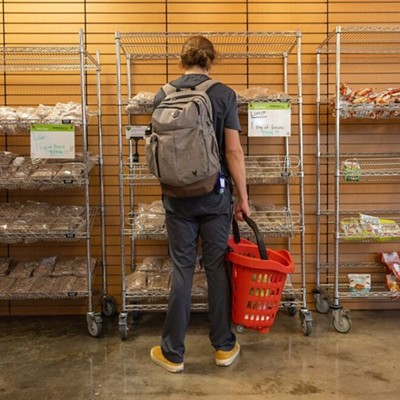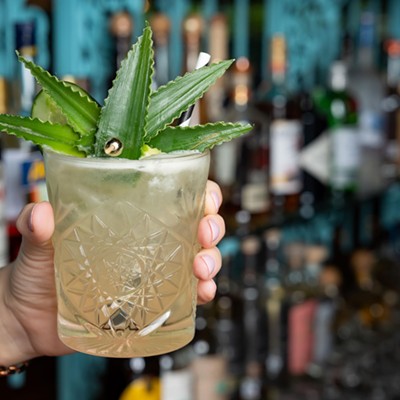This weekend we were invited to a honey-harvesting party at the home of Tom Helm, an urban outdoorsman who in 2006 was the subject of our cover story "Dark Water", in which he and then-Press reporter Josh Harkinson kayaked 40 miles along urban Buffalo Bayou -- from the Galleria area through the Houston Ship Channel to Galveston Bay.
In the time since that trip, Helm has developed a new hobby, what you might call urban foraging. Lately he's been picking mushrooms and fungi in the woods near Memorial Park's bike trails. He's also got a massive garden growing in front of his Heights home with peppers, pomegranate trees, citrus and more. Earlier this year, he installed a new addition -- a three-foot-tall beehive.
This weekend's harvest was the second for Helm's hive. The first was just a few months ago. Even Nancy Greig, director of the Houston Museum of Natural Science's Cockrell Butterfly Center, who showed up to help with the harvest, was impressed with the production of Helm's busy bees.
Here's a simplified version of how the hive and harvest works:
Helm's manmade beehive consists of two sections -- the main hive itself, where the queen and some of the bees live, and a superstructure on top, from which the combs and honey can be harvested without damage to the bee colony itself. Turn out bees don't like it when you steal their food.
Helm donned a beesuit and subdued the bees in the hive with a small smoker. This allowed him to apply butyric acid to the hive; this foul-smelling substance causes the bees to flee the hive long enough to remove the supers. This part is tricky -- if the acid is left on too long, the bees will flee the hive forever.
The supers contain frames that hold a thin plastic pattern for honeycombs. Helm explained that the bees can make the combs on their own, but the plastic guide helps them get started faster. The bees first make the comb, then fill it with honey. Once a comb's section is filled to the bee's liking, the comb is capped off with a wax seal.
Earlier this summer, when Helm harvested his very first batch of honey, he left as much of the wax comb intact as possible. He's also started with only one super. After the first harvest, he added a second super, and because the comb structure was already there, the bees were able to focus more on making honey and less on making comb. Greig said this is probably why the second batch of honey was ready so quickly.
Once the frames are pulled from the super, Helm used a hot knife to cut the caps off the combs. The cuts had to be shallow -- just the very edge of the comb -- so as much of the wax structure remains as possible. This was the funnest part of the harvest. Chunks of melted wax and oozing honey fell into the tub under Helm and Greig's cutting station. All you had to do was pick up a chuck of the sliced honeycomb and suck out the delicious, tangily sweet honey harvest straight from the hive. Greig got a kick out of telling us honey is kind of like bee puke, since enzymes in bees' mouth parts are what turns the collected plant nectar into honey. We didn't care. We felt like Winnie the Pooh.
Once the caps are cut off the combs, the frames are put into a centrifuge (borrowed from the president of the Houston Beekeepers Association), where friends of Helm's took turns spinning the hand crank to draw all the honey out. The honey collects at the bottom of the centrifuge, and once all the supers (16 frames in all) were spun, the drain at the bottom was unplugged. Honey flowed into a seive atop a five-gallon cooler, where the last bits of wax were filtered out. By the end of the night, Helm had more than three gallons of fresh honey at his disposal.
Everyone who attended the party was sent home with a fresh jar of the stuff, and Helm said he's thinking about making mead from the remainder.
Membership to the Houston Beekeepers Association is $20 a year, and if you'd like to get a taste of honey harvesting, you can visit BeeWeaver Apiaries in Navasota, which sells hives to hobbyists and professional bee keepers.






